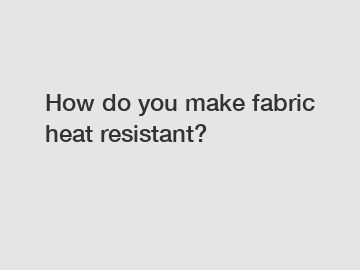How do you make fabric heat resistant?
How do you make fabric heat resistant?
Fabric plays a crucial role in our everyday lives, from the clothes we wear to the upholstery we use at home or in our vehicles. While fabric is often chosen for its aesthetic appeal and comfort, there are instances where heat resistance is a critical factor to consider. Heat-resistant fabrics are essential in various industries, including firefighting, welding, and aerospace. In this article, we will explore the methods and technologies used to make fabric heat resistant.
1. Understanding the Importance of Heat Resistance.

Heat resistance is the ability of a material to withstand high temperatures without being damaged or catching fire. Fabrics that are not heat resistant can easily burn or melt, posing significant risks to individuals wearing or coming into contact with them. Heat-resistant fabrics provide protection from radiant heat, flame, and can help slow down the spread of fire.
2. Using Flame-retardant Treatments.
One popular method to make fabric heat resistant is by applying flame-retardant treatments. These treatments can be either chemical finishes or coatings that alter the fabric's molecular structure to reduce its flammability. Flame retardants work by forming a protective barrier or by releasing flame-inhibiting gases when exposed to heat or flames. These treated fabrics have improved resistance to ignition, reduced flame spread, and self-extinguishing properties.
3. Selecting Inherently Heat-resistant Fibers.
Some fibers have natural heat-resistant properties, making them suitable for applications that require resistance to high temperatures. Fibers such as aramid, including Kevlar and Nomex, have excellent thermal stability and are commonly used in protective clothing for firefighters and industrial workers. Ceramic fibers, such as silica and alumina, are also inherently heat-resistant and find application in high-temperature insulation and aerospace industries.
4. Incorporating Heat-resistant Coatings.
Coating fabrics with heat-resistant materials can significantly enhance their thermal properties. These coatings act as a barrier between the fabric and the external heat source, reducing the amount of heat transferred to the fabric. Silicone-based coatings, for example, provide excellent heat resistance, water repellency, and electrical insulation properties. These coatings are applied to fabrics used in products like oven mitts, industrial curtains, and heat shields.
5. Laminating with Heat-resistant Films.
Laminating or bonding a heat-resistant film to a fabric can increase its resistance to heat and flames. The film acts as a protective layer, preventing direct contact between the fabric and the heat source. Laminated fabrics are commonly used in industries such as welding, where high temperatures are involved.
In conclusion, fabric heat resistance can be achieved through various methods, including flame-retardant treatments, using inherently heat-resistant fibers, incorporating heat-resistant coatings, and laminating with heat-resistant films. The choice of method depends on the specific requirements and desired level of heat resistance for the intended application.
Whether you need heat-resistant fabrics for industrial applications, protective clothing, or any other purpose, it is essential to work with experts in fabric engineering and manufacturing. These professionals possess the expertise to develop fabrics with the required levels of heat resistance while considering other critical factors such as durability, comfort, and cost.
If you have any queries or require assistance with fabric heat resistance solutions, please do not hesitate to contact us. Our team of dedicated professionals will be happy to help.
Want more information on conductive yarn manufacturer, how conductive is stainless steel, polyester fiber cloth? Feel free to contact us.
122
0
0


Comments
All Comments (0)